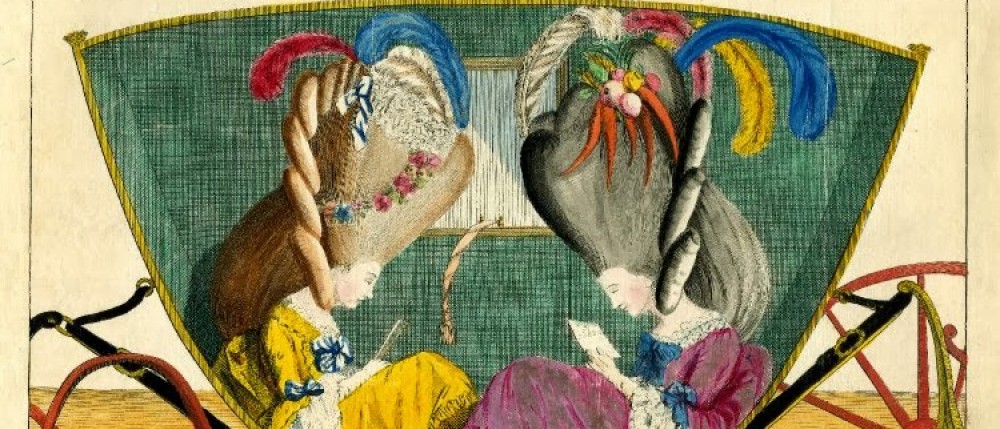The dear memento of a friend that’s gone,
Whose lov’d remembrance time can ne’er destroy;
How much I prize it never can be known,
Tho’ not the emblem of soft smiling joy.
S.B.R.
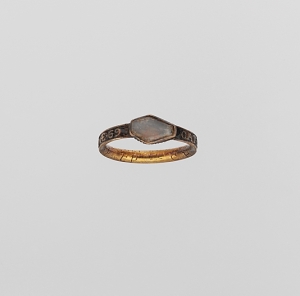
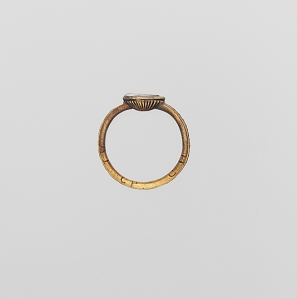 FIGURE A
FIGURE A
Death remained a familiar facet of life in eighteenth-century Western Europe and British North America, and it discriminated neither by gender nor by social class. Similarly, fashion left few facets of society untouched during the 1700s, since the consumer revolution allowed all the classes to take pleasure in some luxury items. Therefore, even death came under fashion’s influence, exemplified by the presence and popularity of mourning rings. Remembrance jewelry not only served as a tangible tribute for lost loved ones, but also revealed the widespread availability and fashion of mourning rings, despite that jewelry was once a luxury item, and the importance of familial relationships during the eighteenth century.
The mourning ring in Figure A, dates back to 1733 and its provenance is Mrs. J. Amory Haskell of New York until 1941. “CAT.D.PEYSTER: OB 8. DEC. 1733 AE 69” is inscribed on the outside of the band, “AP + CP” and “ADP * obiit 2 Aug * 1728 AE 71” are inscribed on the inside of the band and “CH WH” is also scratched on the inside of the band. Thus, it commemorates the deaths of Cat D. Peyster on December 8, 1733, at age 69, and A.D.P. on August 2, 1728, at age 71. Composed of gold, enamel, glass, and human hair, the ring measures 1.9 centimeters in diameter.
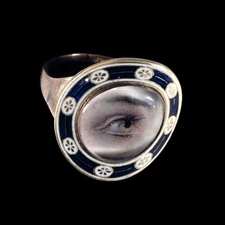 FIGURE B
FIGURE B
Essentially, a mourning ring was a token that commemorated the death of a loved one. The mourning ring in Figure B features a miniature painting of an eye, most likely cut from a portrait of the deceased, as a sort of keepsake. Similarly, the mourning ring in Figure A features an inlay of the hair of the deceased, another form of keepsake. In this way, mourning rings emphasized the close familial connections between the wearer and the subject of the ring, utilizing a piece of the deceased as remembrance. The rings were personalized to remind the wearer of his lost loved one, as evidenced in On a Mourning Ring:
Oft as I view it will the starting tear
Unbidden flow, and fancy will retrace
Those hours when thou, lamented shade, wert near
To charm with every mild attractive grace (S.B.R.).
Therefore, mourning rings inspired emotions and memories in the wearer. However, while mourning rings revealed the presence of sentimental and familial connections in eighteenth century society, their popularity also exposed the vast reaches of the consumer revolution.

Although Western Europeans symbolically wore mourning rings throughout the Middle Ages, a breakout of the Black Plague in London in the early seventeenth century increased their prevalence (“Gold mourning ring”). With the rise of the consumer revolution throughout the mid-eighteenth century, in which more members of society had the ability to buy consumer goods, producers not only offered a greater quantity of items, but also a greater variety. Although most mourning rings featured custom inscriptions, they varied from simplistic gold bands to extravagant pieces set with diamonds, pearls, and other stones, in a design dependent on the popular styles of the time. For instance, early and mid-eighteenth century jewelry represented the popular, Parisian, Rococo style, evidenced by the asymmetric cut of the glass stone in the mourning ring in Figure A. However, when Republicanism took hold during the American Revolution, jewelry embraced the simplicity and symmetry of Neoclassicism (“Not Lost But Gone Before”). Miniature portraits of neo-classical symbols, such as urns and weeping people, painted on ivory also appeared on rings dating to the late 1700’s, such as in Figure C.
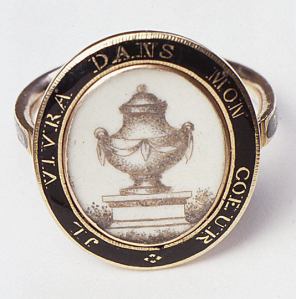 FIGURE C
FIGURE C
The variety of ring designs and stone selections of mourning rings attested to the widespread reaches of the consumer revolution. The fact that the inscribed names in the simple mourning ring in Figure A were not well known suggested that customized jewelry was available and affordable to many classes, not limited to the aristocracy. While mourning rings traditionally memorialized those who passed away, jewelry was still subject to the evolving fashion, novelty, and superfluity that characterized the consumer revolution on both sides of the Atlantic. Originally “the dear memento of a friend that’s gone” (S.B.R.), mourning rings not only served as a peaceful reminder of those who were lost, but they also signified the wealth and social status of the wearer through the elaborateness of their designs and the use of coveted stones.
Wills commonly contained instructions and money for the creation of mourning rings, which were then distributed to relatives and friends. For instance, an article in London’s Telegraph newspaper from February 2, 1797, reported that in Mr. Bushnan’s, the Comptroller of the of the Chamber of London, will, he desired to give mourning rings to three hundred of his brother officers (Telegraph). In this case, not only did family members receive mourning rings, but also those who worked with Mr. Bushnan during his lifetime, such as the mayor of London. Therefore, these rings revealed their wearers’ political and social ranks because they wore the mourning ring of the wealthy Mr. Bushnan. Yet, this article also suggests that among the upper classes, mourning rings seemed to lose much of their sentimentality and intimacy and instead, conveyed patronage and fashion. Essentially, all three hundred recipients of mourning rings could not have been Mr. Bushnan’s closest family and friends. Mr. Bushnan maintained the propensity to impress even after his death. In The Birth of a Consumer Society: The Commercialization of Eighteenth-Century England, author Neil McKendrick quoted critic Cobbett, mentioning Europeans’ “constant anxiety to make a show” (quoted in McKendrick, 28). During the consumer revolution, possessions and clothing symbolized one’s social rank, and mourning rings were of no exception (20). Michael Kwass, in Big Hair: A Wig History of Consumption in Eighteenth-Century France, argued that while fine fabrics and other luxury goods did not permeate the middling classes, “secondary accessories,” in which jewelry can be categorized, “became widely available and, to the consternation of many a moralist, helped to change the appearance of the middling and to some extent the lower classes” (Kwass, 640). These intermediate goods, such as mourning rings, straddled the line between luxury and necessity. They could be elaborate, and at the same time, symbolize the death of a loved one. Thus, although mourning rings served an essential purpose beyond appearance, wearers still realized that the style and quality of the rings conveyed social class.
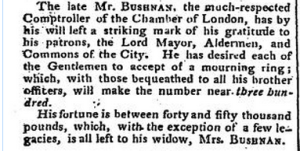
However, because death visited all social classes, mourning rings showed a sense of equality in that both the wealthy and the impoverished wore mourning rings. As McKendrick stated, “Some designers managed to impose a remarkable uniformity of style on all classes in the last decade of the century – the rich had Adam and the rest had Adamesque” (McKendrick, 12). In this way, while more expensive mourning rings featured more intricate designs and more expensive stones and metals, the less expensive mourning rings achieved the same effect, for instance, by replacing diamonds with enamel and glass, such as in Figure D. Although the increased availability of luxury items suggested greater social equality during the consumer revolution, the propensity for social emulation of the upper classes, such as striving for the appearance of diamonds in a mourning ring, nonetheless, engendered greater social competition (11).
 FIGURE D
FIGURE D
Although mourning rings possessed a sense of sentimentality and intimacy, they did not exist outside the fashionable world of the consumer revolution. Rather, these symbols of death embraced the age of materialism and luxury, so that death became a fashion statement in itself.
Bibliography
“Gold mourning ring with a painted eye.” The British Museum. The British Museum, n.d. Web. 11 Mar. 2014. <https://www.britishmuseum.org/explore/highlights/highlight_objects/pe_mla/g/gold_mourning_ring_with_a_pain.aspx>. (Figure B)
Kwass, Michael. “Big Hair: A Wig History of Consumption in Eighteenth-Century France.” American Historical Review (2006): 631-59. Print.
McKendrick, Neil. “The Consumer Revolution of Eighteenth-Century England.” The Birth of a Consumer Society: The Commercialization of Eighteenth-Century England. London: Europa, 1982. 9-33. Print.
“Mourning Ring.” The Metropolitan Museum of Art. The Metropolitan Museum of Art, n.d. Web. 11 Mar. 2014. <http://www.metmuseum.org/Collections/search-the-collections/5263?rpp=20&pg=1&ao=on&ft=mourning+ring&pos=3>. Museum Accession Number: 41.42.1 (Figure A)
“Mourning Ring.” The Metropolitan Museum of Art. The Metropolitan Museum of Art, n.d. Web. 11 Mar. 2014. <http://www.metmuseum.org/Collections/search-the-collections/200677?rpp=20&pg=1&ao=on&ft=mourning+ring&pos=7>. Museum Accession Number: 50.187.1 (Figure C)
“Mourning Ring.” The Metropolitan Museum of Art. The Metropolitan Museum of Art, n.d. Web. 11 Mar. 2014. <http://www.metmuseum.org/Collections/search-the-collections/5264?rpp=20&pg=1&ao=on&ft=mourning+ring&pos=4>. Museum Accession Number: 41.42.2 (Figure D)
“Not Lost But Gone Before: Mourning Jewelry.” Historic New England. Historic New England, n.d. Web. 11 Mar. 2014. <http://www.historicnewengland.org/collections-archives-exhibitions/online-exhibitions/JewelryHistory/themes/Mourning.htm#mourning2>.
R, S. B. “On a Mourning Ring.” The European magazine, and London review; containing the literature, history, politics, arts, manners and amusements of the age. By the Philological Society of London 1782-1826: 51. Eighteenth Century Collections Online. Web. 11 Mar. 2014. <http://find.galegroup.com/ecco/infomark.do?&source=gale&prodId=ECCO&userGroupName=uclosangeles&tabID=T001&docId=CB3330470308&type=multipage&contentSet=ECCOArticles&version=1.0&docLevel=FASCIMILE>.
“Skeleton Ring.” The British Museum. Trustees of the British Museum, n.d. Web. 11 Mar. 2014. <https://www.britishmuseum.org/explore/young_explorers/discover/museum_explorer/europe/death/skeleton_ring.aspx>.
Telegraph [London] 2 Feb. 1792, Arts and Entertainment. 17th-18th Century Burney Collection Newspapers. Web. 11 Mar. 2014. <http://find.galegroup.com/bncn/retrieve.do?sgHitCountType=None&sort=DateAscend&prodId=BBCN&tabID=T012&subjectParam=Locale%2528en%252C%252C%2529%253AFQE%253D%2528tx%252CNone%252C13%2529mourning%2Bring%253AAnd%253ALQE%253D%2528gs%252CNone%252C17%2529%2522Arts%2Band%2BSports%2522%2524&resultListType=RESULT_LIST&searchId=R2&displaySubject=&searchType=BasicSearchForm¤tPosition=4&qrySerId=Locale%28en%2C%2C%29%3AFQE%3D%28tx%2CNone%2C13%29mourning+ring%3AAnd%3ALQE%3D%28gs%2CNone%2C17%29%22Arts+and+Sports%22%24&retrieveFormat=MULTIPAGE_DOCUMENT&subjectAction=DISPLAY_SUBJECTS&inPS=true&userGroupName=uclosangeles&sgCurrentPosition=0&contentSet=LTO&&docId=&docLevel=FASCIMILE&workId=&relevancePageBatch=Z2001481163&contentSet=UBER2&callistoContentSet=UBER2&docPage=article&hilite=y>.
